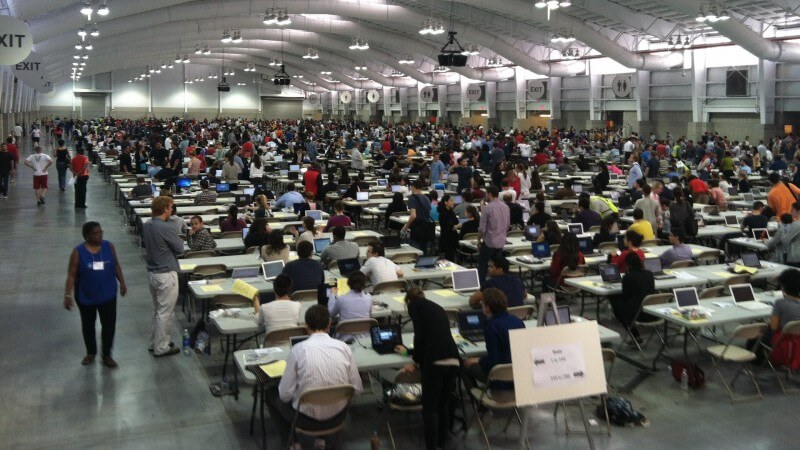
Summary: While bar exam passage rates have improved overall, they are still at all-time lows.
Now that the state results for the July 2016 bar exam have been released, it’s time to step away from today’s turkey and process what we’ve learned. Nationally, there has been a slight uptick in scores, which is counter to what was expected so that’s a plus. New York, which is notorious for its difficult exam, saw an increase in its passage rate. Texas and Washington, DC also saw a rise. However, there have been drops in some states like California, which have been a cause of concern. This year, their overall pass rate was 43%, compared to last year’s rate of 46.6%. New Mexico, which recently adopted the Uniform Bar Exam, saw an even more dramatic dip from last year’s 81% pass rate to 68%.
- Related: 10 Tips for Surviving the Bar Exam
To add more perspective, the average score for test takers is still lower than the past, even if the pass rates are improving.
“But there is an important matter of perspective: a 140.3 is still near all-time lows. The July 2016 score is the second-lowest since 1988 (the lowest being July 2015),” Pepperdine University School of Law professor Derek T. Muller wrote on Excess of Democracy. “In an absolute sense, the score is not good. Indeed, while modest improvements in the bar passage rates in most jurisdictions will be good news for those passing students and for law schools looking for any positive signs, they will not approach the pass rates of three or four years ago.”
So who’s to blame for the disappointing July 2016 bar exam results? Right now, there are two theories floating around.
The UBE helped some states and hurt others.
Several states have adopted the UBE, and New York and New Mexico have shown that the test has mixed results. New York’s test takers improved their bar passage rate from last year by 4% while New Mexico dropped by 13%. One theory is that New York’s test got easier while New Mexico’s got harder.
“One theory is that graduates did better on an exam focused on New Mexico law, because that’s what they’re learning in law school. New York results have been improving since it adopted the UBE, but that may be related to the fact that the UBE is easier than the [former] New York bar exam,” Denise Roy, co-president of the Society of American Law School Teachers’ board of governors, told ABA Journal.
Certain law schools are bringing the numbers down.
It has become an alarming trend for some law schools to lower their admission standards. The number of potential qualified applicants have decreased over the years, so to meet student quotas, law schools have let in students with low LSAT scores or bad grades. This has resulted in a correlation between low LSAT scores and low bar exam results.
“Given that the LSAT profiles of matriculants and of law schools for fall 2013, fall 2014 and fall 2015 are less robust than those for fall 2011 and fall 2012 (the classes that graduated in 2014 and 2015, respectively), one can anticipate that the declines in median MBE scaled scores and corresponding bar passage rates in 2014 and 2015 will continue in July 2016, 2017 and 2018 absent increases in attrition, significant improvement in academic support programs at law schools, or improved bar preparation efforts on the part of graduates,” Jerry Organ wrote on the Law Professors Blog Network.
State bars released passage rates on individual schools, and this information shows how some schools can drag down the state bar passage rate average. For instance, Pennsylvania saw its lowest bar passage rate (69.3%) since 2003, according to The Legal Intelligencer, but there were clearly highs and lows. Top tier school University of Pennsylvania had a bar passage rate of 98% for first time takers, for example, while Widener University Delaware Law School had only 48% of its first timers pass. Dean Rodney Smolla of Widener said that this drop was surprising, considering the school had a 74.5% pass rate last year, and that the school was taking steps to determine what caused the change.
How to improve scores?
Law schools with low passage rates need to be proactive with helping prepare their students to pass the bar exam, and these steps can include changing curriculum or hiring help. Florida’s Ava Maria School of Law is a perfect example of how directly addressing the problem works. After a disappointing 2015 bar exam passage rate, the school hired a bar passage director, and this move jumped the school’s bar passage rate by 19% in one year.
- Related: July 2016 Bar Exam Results-Texas
- Related: July 2016 Bar Exam Results-New York
- Related: July 2016 Bar Exam Results-Florida
- Related: July 2016 Bar Exam Results-California
Photo courtesy of Youtube.
Why do you think the bar exam passage rates and scores are low? Let us know in the comments below.
